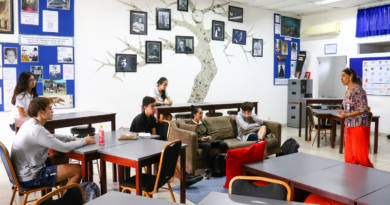Primary eNews – January 15, 2021
Building Community in Grade 4
Our new unit of inquiry is How the World Works and focuses on structures and human ingenuity. Beginning our unit with tuning into the concepts: connection and design, students have been exploring connecting ourselves as a learning community. This has also been a wonderful opportunity to develop our technical skills across our Google learning platform.
Students explored Google Drawings to create lines, shapes, text and background, designing a small patch of ART to add to a class collage. This collaborative canvas has become our Grade 4 Google Classroom Banner, creating a sense of ownership of our digital classroom.
From this premade design…

… to a community design.

Grade 4 are also co constructing a WONDER WALL using the Padlet platform. This is a common space for sharing interesting information, action, words and questions that we may have as our unit develops. Having different types of shared spaces, while learning online, encourages all of our students to have a voice and engage with activities, in ways that best suit their talents.

Still new for the students, we are modeling and guiding using a collaborative space as they develop the confidence to post independently.
We already have some great questions to guide our inquiry:
- How do you weigh buildings?
- How do they build skyscrapers?
I am sure we will have many more.
Counseling
I want to remind you or bring your attention to an excellent site for all things tech-related, Common Sense Media. As a parent, it can feel overwhelming to keep up with the latest available apps, movies, shows, books, and research. Common Sense Media has endless, research-based quick tips for parents. Don’t know what Tik-Tok is, much less why kids are using it? They have a guide with a video to inform you. Not sure if your 12-year-old should be watching Trickster? They provide recommended viewing ages for shows and movies and often have parent and kid ratings. Want to buy a book for a child’s birthday party and are not sure what would be exciting or appropriate? Common Sense Media has “Best of” lists for books, music, streaming, games, and so on. They also provide articles to support parents, like this one on keeping kids motivated for online learning. Common Sense Media is a site worth joining and bookmarking. Counseling
Take care,
Sharon
A New Year! A Time for Setting Goals and Changing Behaviours
by Jackie Wyncoll, BIS Student Support
If you’re like me, you have behaviours you want to change, things you want to get better at or something new you want to try. I love to set goals for the New Year… and frequently that means setting myself up for failure!
THIS year…I’m going to be more organised! I’m going to ask more questions in class! I’m going to the gym 7 days a week! I’m not going to fight with my brother! I’m going to speak Bahasa Indonesia fluently! I’m going to eat healthier! And so it goes….. for the next 13 days or so, maybe… despite my best intentions for my goal to last forever!
So, how do we set goals… and stick with them long enough that we ultimately change a behaviour and create a new habit?

A. Setting a Goal
- How do you choose a goal?– there should be a strong need, a strong desire to change or a strong interest if you want to achieve success with your goal.
- Does your goal have clear plans and concrete actions- not just wishful thinking? Eg: I wish I could take better notes in class. vs. I will use the Cornell notetaking system to take notes in class and review them after school each day.
- Is it a SMART goal?
- Specific – your goal should say exactly what you plan to do to achieve the goal. Eg. I want to be more focused during class vs. I will not have any personal or irrelevant tabs/windows/behind-the-scene-screen open during class.
- Measurable – how will you know you have achieved your goal?
Eg. I will ask more questions in class vs. I will ask 2 questions in each class everyday. - Actionable – goals should be worded so they imply action.
Eg. Be more organised vs. File my notes in the correct folders every day after class/school. - Realistic – your goals should be achievable.
Eg. Keep my laptop camera on for class everyday vs Allow my camera to be off if I’m having a crummy day and I have let my teacher know. - Time-bound –Short term goals are often more achievable. Long-term goals should have shorter-term milestones attached to them. Eg. I will have all 6s by the end of semester 2. Vs. By the end of this term I will have at least a 4 in all my classes.
- Are you tracking your progress? Use a calendar or other tool to track your goal and make note of issues that hinder your success so that you can rectify them quickly.

B. What Motivates Change?
Parents who are trying to help your child implement some type of behavioural change that they know will be good for them should be aware that…..
Threats and warnings do not work- if we try to instill fear in someone in order to affect change the person responds by shutting down or simply avoids the task. Alternatively, research has shown that people tend to take in information they want to hear, and usually this is something that has a more positive outcome. We are more likely to act on things we see as positive or make us feel good about ourselves. Fear induces inaction while the positive reinforcement and gains induce action. So- try positive motivation with positive incentives to support your child
- Give your child control of the outcome.
- Highlight the progress, not the decline.
**Remembering the saying, ‘a child becomes who they see in your eyes’ is an important reminder for us to lift our children up, to focus on the positive steps they make towards their goals instead of what they didn’t do.
C. Consistency and Commitment
Change is hard and takes a lot of effort. Be gentle with yourself/with your child as you try to break a negative habit and implement a change. Slip ups are allowed! The most important thing is to be consistent– to work at the goal everyday- this will start a neuro-pathway in the brain for that new behaviour and you will begin to operate on ‘auto-pilot’.
“What defines us is how well we rise after falling”- Set realistic goals, track your progress, stay positive, be consistent, don’t give up.

Links to References:
Achieving Behavior Change Through Goal Setting
The 1 Minute Secret to Forming a New Habit
TEDx How to Motivate Yourself to Change your Behavior- Tali Sharot



